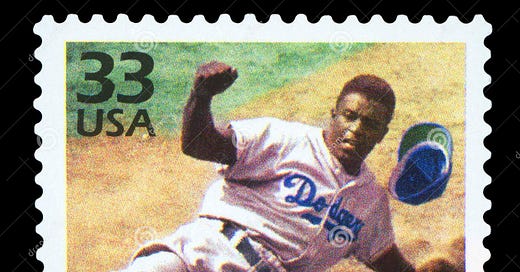"Not Deeply Rooted in the Nation's History"
Two of the three topics Linus Van Pelt learned to never discuss with others are politics and religion. Each of those subjects have their own subsects that prove particularly treacherous for conversation, and abortion may be A-1 since it intersects the two.
If you’re holding your breath, you can exhale; The Press Break won’t be getting into this specific issue. Plenty of other publications will no doubt inundate you with opinions and facts and, unfortunately, no shortage of misinformation in the coming days, weeks and months.
Besides, this is a sports newsletter. But, as such, the leaked Justice Alito draft contains language that I find troubling: "
“…not deeply rooted in the Nation’s history…”
As precedent for reversing settled law, the above wording should bother you. What exactly constitutes “deeply rooted,” exactly? Roe v. Wade is 49 years old, just a year younger than one of the most influential pieces of law impacting sports, Title IX.
Title IX turns 50 next month. While the wide-ranging, landmark case covers a variety of areas, Title IX’s influence is most recognized among the masses in sports. Women’s athletics have a long and unfortunate history of battling against political sentiment, so a Supreme Court case being the measure needed to open opportunities is unfortunately not surprising.
For example, in her excellent book Dust Bowl Girls on a barnstorming Depression-era college basketball team, Lydia Reeder touches on the efforts of Lou Hoover — the First Lady at the time — against athletic competition deemed unladylike. That included basketball.
Women’s hoops is now one of the fastest-growing sports in popularity, evident in the most recent NCAA Tournament’s record-setting TV ratings.
And yet, at the same time, those in the game are still left fighting for progress. Photos of the sub-par equipment made available to the women’s teams during the 2021 NCAA Tournament underscored the inequalities that remain even with Title IX.
The ruling remains a work-in-progress. At 50 years old, the advancements made as a result of Title IX could hardly be considered deeply rooted in the Nation’s history.
Meanwhile, Title IX is less than a decade younger than the Civil Rights Act.
Sports have long been at the forefront of ushering in change. I’m not so naive as to view this as entirely altruistic; there’s an unquestionable pragmatism to athletics often being ahead of society-at-large in matters of equality.
Nevertheless, the examples throughout the 20th Century and into the 21st are numerous and well-studied.
1934: Future president Gerald Ford threatened a boycott when upcoming Michigan opponent Georgia Tech demanded the Wolverines play without Black team member Willis Ward.
1946: The North Carolina Central (then the North Carolina College for Negroes) played the Duke medical school’s basketball game in a closed-door scrimmage — closed-door because of the threat of violent backlash to a Black team playing a segregated, Jim Crow-era university’s squad.
1947: One year before President Truman desegregated the military, Jackie Robinson became the first Black man in Major League Baseball.
1963: A year prior to President Johnson signing the Civil Rights Act, an integrated Loyola basketball team faced segregated Mississippi State in “The Game of the Change” en route to a Ramblers’ national championship.
1966: Texas Western’s all-Black starting lineup led the Miners to a national championship over Adolph Rupp’s all-White Kentucky Wildcats.
1970: Even as schools in the South began to desegregate with the federal repeal of Jim Crow laws, the tide (pardon the pun) for integration in sports turned with USC’s rout of Alabama.
Are any of the above examples either of law or sports deeply rooted in history? A person could very well have lived through each — and any time I actually write out the years in which landmark moments of racial equality in sports occurred, I’m continuously astounded at how recently it all happened.
And while not quite as explicit, examples of sports leading to greater awareness for people who face discrimination remain prevalent in more modern times. It’s only been a decade since Linsanity swept the nation, as Jeremy Lin became the NBA’s first Asian-American superstar.
Jason Whitlock fired off a predictably hacky, tasteless and racist joke at Lin’s expense amid the guard’s historic run with the New York Knicks, offering up a stark and sad reminder that anti-Asian discrimination remained relatively mainstream into the 2010s.
Likewise, SEC Defensive Player of the Year Michael Sam’s selection in the 2014 NFL draft sparked a firestorm of thinly veiled complaints that spoke to the slow process the gay community endured of winning begrudging acceptance. Remember, in 2014 we’re talking just a handful of years after politicians campaigned on banning gay marriage as a pillar of their platforms and dark money pumped untold millions into propaganda blitzes against legislation like California’s Prop 8.
In spite of the vitriol that followed Sam, I don’t think it’s unfair to credit athletes like him and Jason Collins publicly coming out for softening public sentiment and eventually leading to the SCOTUS legalizing gay marriage in 2015. Carl Nassib coming out just last year continues the progress made against stereotyping and discrimination. That him doing so was so landmark demonstrates the long way we still have to go, however.
But if the standard for rights is that they’re ambiguously “deeply rooted” in history, then how do we ever makes any of these moves forward?



